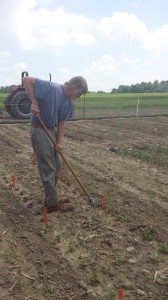Brace yourselves. I could get long-winded here (but there are a lot of pictures this week, so I’d like to think you won’t get bored).
Earlier in July, we had a training set up where we discussed the protocol for farm visits for our project and the identification of our target species–knapweed (I say ‘our’, there are two of us completing similar internships in different locations, Kaitlyn is in Saratoga). I have spoken very little in my blogs about my actual project for the summer. The process to work out all the kinks in our protocol has been a long one. I would attach a link where you can find good information on knapweed, but I think that Kaitlyn’s blog sums it up well as she explains much more about it and about our project. There are four major species of interest in New York State that we will be looking for and mapping. We will also be documenting any natural predators of it that we find. All of this information will be helpful as a preliminary step in setting up further research on knapweed in the future.
Since the training, I’ve still been keeping busy working on other things as I have traveled to four different sites to count densities and percent cover of various swallow-wort plots set up by the USDA. Two sites were near Aurora, one was on Lake Ontario at Wehle State Park, and the other in Rochester.
We count the swallow-wort plants larger than ten centimeters and the seedlings smaller than that in each of the four corners of each plot using quadrats of various sizes. At one site, we even got to set up eight new plots–a process which I found really interesting because it’s just another stage of research that I get to witness. One of the best parts of some of that work was that half of it was in the woods! That means nice and cool shade and cover–so opposite of a lot of the field work we do. The downsides: bug-bites and lots of vines and fallen trees to trip over. Above you see Melissa and Scott counting swallow-wort at the different sites and the white rectangular frame is the quadrat.
Last week, we attended a Field Day at Musgrave Research Farm near Aurora. It was interesting to tour the research farm where I have spent so much time this summer working on various projects. We learned about some of the other projects that are being executed there and I was able to see some familiar faces  from across the state that I know from previous work in Extension.
from across the state that I know from previous work in Extension.
Speaking of Musgrave, this is where the lettuce and galinsoga project is located and due to a lack of rain, we had to water the field by hand–watering 3,520 plants with a liter of water each (‘we’ being a loose term since I only helped with part of it since I wasn’t there the first day. A big shout out goes out to the other girls in the Weed Ecology lab who carried literal metric tons of water onto that field in order to water all of those plants).
I also had the opportunity to travel to Geneva to the Fingerlakes Institute for a PRISM meeting. No, when I say PRISM, I don’t mean a shape or an NSA program. PRISM stands for Partnership for Regional Invasive Species Management. There are eight of these PRISMs in New York State that each manage their own region accordingly. It was interesting to be present at the Fingerlakes region PRISM meeting as they discussed species of concern and updated each other on various efforts on invasive species within their region in the areas of aquatic, terrestrial, agriculture, and education and outreach.
Coming up! Don’t miss out on what I report on the Northeastern Weed Science competition that we’re attending next week at PennState and also on Empire Farm Days–a three day adventure talking to the public about our project and knapweed.













